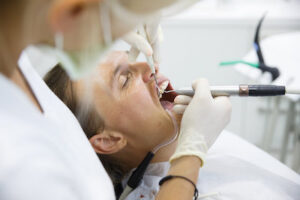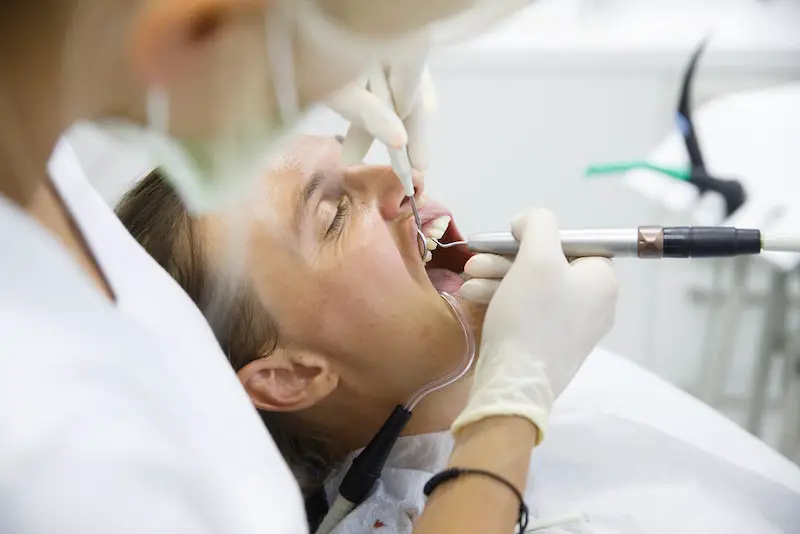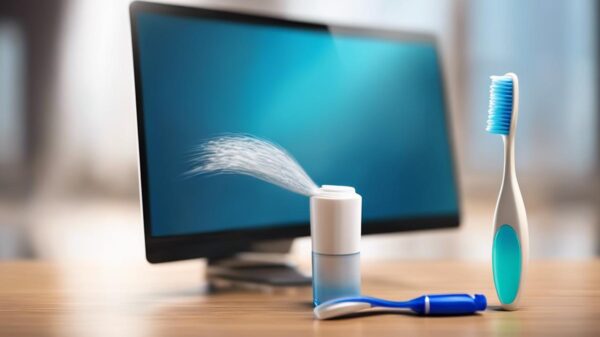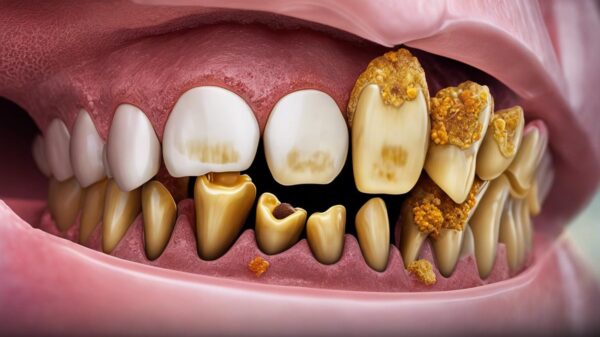Common Symptoms of Periodontitis
If you are concerned you have periodontitis it is important to take get diagnosed and take care of it swiftly. There are things you can do at home and things you may have to get done at a dentist. Either way, early detection, and care are key. In this article I will outline what periodontitis is, its symptoms, and what you can do to prevent and treat it.
What is periodontitis? Periodontitis is a bacterial infection that affects the soft structures around your teeth, causing damage to the gums and jawbone. It is an extremely common condition that begins as a red, swollen, and tender gum near a tooth. Left untreated, periodontitis can eventually result in bone loss and looseness of teeth.
Periodontal disease (also known as gum disease) is a common type of chronic inflammation that begins with bacteria in the mouth, particularly plaque. Symptoms of periodontitis include bleeding gums when brushing, swelling, and redness.
Plaque is a sticky film of bacteria that constantly forms on teeth (most bacterial growth occurs within 24 hours). It consists mostly of gram-positive anaerobic cocci and rods, with the genetic material bound to their cell walls. The only way to remove plaque build-up on your teeth immediately is through proper oral hygiene such as flossing.
Although plaque control is often at the center of periodontal disease, it does not explain why some people have healthy mouths while others develop gum disease. Some people have good immune responses that keep the gums healthy, while others are susceptible to disease even though they do everything right. So, do not feel ashamed if you develop periodontitis, it can, unfortunately, happen to anyone. However, there are things you can do to help.
Stages and Symptoms of Periodontitis
The early stage of periodontal disease is called gingivitis, which means inflammation of the gums. Although you may notice bleeding when brushing or flossing your teeth, this is actually a good sign since it means your body is fighting the bacteria. When the gums become swollen and red, this is another indication of gum disease (inflammation). The immune system sends white blood cells to kill the bacteria and repair tissue damage caused by the bacteria’s toxins.
Not all cases of gingivitis lead to periodontitis. However, this is a good time to learn how to control the plaque and avoid advanced periodontal disease. Once gingivitis begins, it takes only a few days before your immune system starts working on the problem.
However, if you do not make an effort to clean away the plaque, especially at night when most bacteria are active, the bacteria could begin to penetrate deeper into the gums and cause permanent damage.
When Gingivitis Turns Into Periodontitis
 If left untreated, gingivitis can lead to periodontitis. Periodontitis is the more advanced stage of gum disease, which occurs when your immune system tries to fight plaque that has spread deep within the tooth sockets or below the gum line.
If left untreated, gingivitis can lead to periodontitis. Periodontitis is the more advanced stage of gum disease, which occurs when your immune system tries to fight plaque that has spread deep within the tooth sockets or below the gum line.
This bacteria spreads easily by producing a sticky mesh that holds on tight to teeth and gums.
If you have healthy blood vessels near the gums, they will bring infection-fighting white blood cells through tiny openings in the teeth and into the pockets between your gums and teeth.
However, if there are not enough healthy blood vessels or if they have been damaged by toxins from bacteria, this defense system cannot work properly and gum disease will progress.
If your immune system cannot remove the infection in your mouth, even though it is constantly working on the problem, periodontitis will set in. The gums begin to pull away from the teeth (recede), causing large areas of tissue to be exposed. This will lead to an increased likelihood of food particles and bacteria getting stuck in the gaps called “periodontal pockets.”
If you notice your gums receding, make an appointment to see a dentist or medical professional immediately.
The Four Stages of Periodontitis
1. Initial Lesion or Early Disease: At this stage, the plaque has accumulated below the gum line, but it is still confined to the tooth with only mild gum inflammation.
2. Moderate Lesion: At this stage, more of your gums are affected and bone loss is starting to appear in the mouth. The bone may also be lost along the root surface of some teeth due to gum recession or trauma caused by sharp teeth or ill-fitting dental work.
3. Advanced Lesion: As gum recession increases, the roots of your teeth will be more exposed and appear longer than they used to be. Bone loss has also increased and most of the root surfaces are now unprotected by gums or bone that would normally prevent bacteria from reaching the root surface. If left untreated, bone loss will continue to progress and teeth may become loose.
4. Severe Lesion: At this stage, many root surfaces are now unprotected and gums can pull away from the teeth forming deep periodontal pockets where bacteria accumulate. If periodontitis is not treated before it reaches this point, supporting bone around the teeth can be lost, causing them to loosen and possibly fall out.
Periodontitis Treatments: Prevention
Prevention is the best way to avoid periodontitis. You should begin practicing healthy oral habits right away – brush your teeth twice a day for at least 2 minutes each time, floss daily, visit your dentist regularly for cleanings and checkups.
Proper oral hygiene can prevent periodontitis. Your dentist can provide thorough teeth cleaning during each visit to prevent plaque from accumulating on the surfaces of your teeth.
If you already have periodontitis, you need to see your dentist right away. Periodontal disease has been linked to other health problems such as diabetes and cardiovascular disease.
The primary cause of periodontitis is plaque (bacteria infecting the bacterial biofilm in your mouth), and it can spread from tooth to tooth.
One of the most common signs of periodontitis is bad breath, which may be caused by food particles getting trapped between teeth and gums. Specialized gum treatment can eliminate these particles and keep your gums healthy.
Preventing Periodontitis at Home
Many people do not know that they could be treating their gum disease (periodontitis) at home! Gum disease is very common, but it never hurts to learn more about what you can do to take care of your teeth.
1. Toothbrush: The number one thing you can do at home is brush your teeth. Make sure you are always doing it twice a day, and brush for at least two minutes. You want to pay attention to the gum line because that is one of the main areas affected by gum disease.
2 . Floss: Using floss regularly also helps with gum disease! This is because it will remove any food that is stuck in the gum line. This could lead to infections, so always floss your teeth every day – whether you are sick or not!
3 . Mouthwash: Using mouthwash regularly can prevent bad breath, but it also prevents bacteria from sticking to the gums. If this happens, brushing and flossing will not be as effective.
4. Boost your immune system: Your body’s immune system is what fights off infections and diseases, so if you have a weak one that means it has a harder time fighting the infection from gum disease. Try eating more fruits and veggies! When you feel sick, remember to always wash your hands so you don’t spread the infection to others.
5 . Visit your dentist for regular cleanings: You can prevent gum disease by going to your dental checkups, but it is also good to know that you could get rid of the infection if it has already occurred with a few treatments at the dentist office. Your dentist can:
How to Treat Periodontist: Home Remedies
If you have or suspect you have periodontitis it is always imperative to seek a professional. However, if you have a beginning stage of gum diseases such as gingivitis or you are wanting to help along the process, here are a few things you can do at home to help.
Tooth Oils
You can use oil on your teeth to help get rid of plaque build-up on your teeth. A common oil to use for this is coconut oil. However, there are specific oils you can get from the store. You just swish the oil around in your mouth and it coats your teeth for 20 to 30 minutes.
Saltwater Rinses
You can pair saltwater with lukewarm water to wash your mouth out a couple of times a day. This will help ease inflammation. In addition, it can rinse out hard to get food particles and remove bacteria count. This is a great way to soothe irritation caused by periodontitis.
Tumeric
Tumeric is an antioxidant. This is so important when you are trying to treat periodontitis. In addition, it is an anti-inflammatory. This provides pain relief when used on inflamed gums caused by periodontitis. You can brush your teeth with it twice a day, or create a pack out of turmeric and water.
Tea Tree Oil
Tea tree oil is an antiseptic. When you add tea tree oil to your toothpaste it can kill additional bacteria in your mouth that can’t be gotten by toothpaste alone.
How to Treat Periodontitis: When to Seek Professional Help
 Going to get dental work done can be an unpleasant experience for many. However, Periodontitis is not something to be messed with. If you suspect you have periodontitis it is important to seek professional help immediately.
Going to get dental work done can be an unpleasant experience for many. However, Periodontitis is not something to be messed with. If you suspect you have periodontitis it is important to seek professional help immediately.
Your dentist can recommend treatments that are non-invasive if this issue is found sooner rather than later. However, if our case is in a later stage, oral procedures may have to be taken. However, getting periodontitis taken care of is worth it!
Dental technology has come a long way. Making sure you have a healthy mouth is so important. Talk to your dentist today about all of your options.












